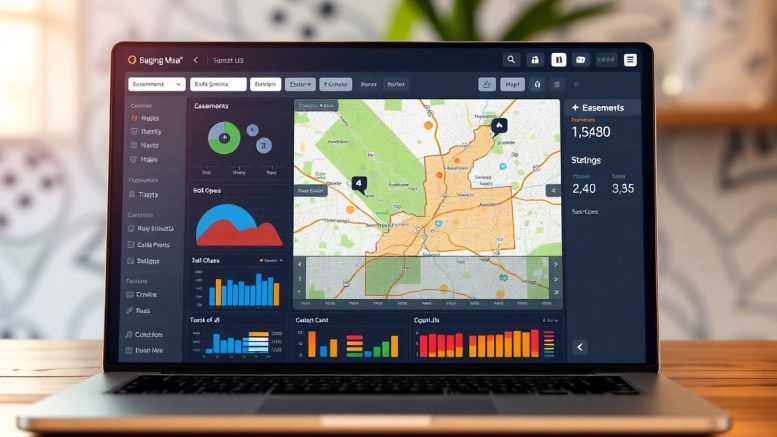Most counties today face growing pressures to manage their infrastructure and land use effectively. Investing in digitizing easements and right-of-way (ROW) data can enhance your decision-making capabilities and streamline operations. By leveraging technology to maintain accurate and accessible records, you can improve transparency, facilitate planning, and reduce potential disputes over land use. This transition not only saves time and resources but also strengthens community engagement and collaboration with stakeholders, ultimately setting the stage for more efficient governance.
The Transformative Power of Digital Data Management
Digital data management revolutionizes how counties handle easements and rights-of-way (ROW). By converting physical records into a cohesive digital system, you gain real-time access to critical data, facilitating informed decision-making. This transformation not only enhances operational efficiency but also ensures that stakeholders can engage with up-to-date information, leading to better community outcomes and compliance adherence.
Enhanced Accessibility and Transparency
With digitized data, accessibility improves significantly. Stakeholders can quickly retrieve easement and ROW documents from any location, enhancing transparency in government operations. This openness fosters public trust, as you provide citizens with easy access to pertinent information that affects their communities.
Streamlined Processes in Easement Management
Digital management streamlines easement processes by automating workflows, leading to faster approvals and reduced paperwork. You’ll find it easier to track requests, coordinate with various departments, and update records promptly. Such efficiency not only saves time but also minimizes the risk of errors in data entry and file handling.
Automated notifications and task assignments ensure that all involved parties remain informed, significantly cutting down on delays that often plague traditional methods. By utilizing digital platforms, you can implement standardized procedures for managing easement requests, allowing for consistent evaluation and prioritization. Enhanced tracking systems enable you to monitor the status of requests in real time, leading to improved communication and more timely decisions. This efficiency not only bolsters your team’s productivity but ultimately leads to better service for the community you serve.
Cost Efficiency: The Financial Case for Digitization
Investing in the digitization of easements and ROW data significantly enhances cost efficiency for counties by streamlining processes and reducing the resources required for ongoing maintenance. Traditional paper-based systems often necessitate extensive labor for data retrieval and record-keeping, leading to inflated operational costs. Digitization eliminates much of this redundancy, allowing your staff to focus on more strategic tasks while ensuring rapid access to crucial data.
Long-term Savings through Reduced Administrative Burden
Transitioning to digital formats alleviates the administrative burden associated with managing physical records. You can expect reductions in labor hours spent on filing, searching for documents, and processing requests. This efficiency not only frees up staff time for more impactful projects but also translates to substantial long-term savings in operational costs.
Avoiding Costly Errors with Accurate Data
Accurate data is the backbone of effective decision-making; digitization reduces errors prevalent in manual entry and physical paperwork. You may face significant costs from miscalculations in easement areas or mismanagement of ROW usage, which can lead to legal disputes or project delays. Effective digitization minimizes these risks by facilitating data accuracy and consistency.
Costly errors often arise from manual data handling, where misentries skew project parameters and lead to unexpected expenses. By implementing a digital system, you leverage automated processes that improve data integrity. For instance, counties that have shifted to digitized easement management report a 30% decrease in error rates related to property descriptions and boundaries. Such accuracy not only saves you potential legal costs but also enhances stakeholder confidence in your planning and operational capabilities.
Improving Public Services with Up-to-Date ROW Information
Access to current ROW data streamlines public service delivery by enabling efficient maintenance and upgrade schedules. With immediate access to information regarding land use agreements, utilities, and legal restrictions, you can enhance transparency and responsiveness in service provision, ensuring that community needs are met effectively and efficiently.
Facilitating Better Infrastructure Planning
Accurate and current ROW information is vital for strategic infrastructure planning. You can identify potential conflicts and opportunities when integrating new projects with existing rights-of-way, which minimizes delays and promotes more effective use of resources. This proactive approach helps you prioritize developments that align with community growth and sustainability goals.
Supporting Environmental and Community Initiatives
You can leverage updated ROW data to better assess environmental impacts and align community initiatives. For instance, understanding the location of easements allows for informed decisions regarding conservation efforts, public green spaces, or managing stormwater. These insights help you engage with stakeholders and foster community support in sustainability practices.
Expanding on the benefits of supporting environmental and community initiatives, incorporating digitized ROW data allows you to identify areas for potential restoration or conservation projects. By analyzing this data, you can target regions that would benefit from eco-friendly developments or conservation efforts. Collaboration with local environmental groups becomes more streamlined as you share precise geographical data, enhancing community engagement. Your ability to respond to environmental concerns swiftly—such as flood risks or habitat preservation—becomes much stronger, positioning your county as a proactive leader in sustainable development. Additionally, inclusion of community input in planning processes fosters trust and encourages public participation, ensuring that projects resonate with local values and needs.
The Competitive Advantage of Digital Infrastructure
Investing in digital infrastructure for easement and right-of-way data creates a significant edge, allowing counties to operate more efficiently and transparently. With accessible, organized data, you can streamline operations, reduce costs, and enhance decision-making processes. This agility often translates into improved service delivery and stronger community trust, ultimately positioning your county as a forward-thinking leader in the digital age.
Attracting Investment and Development
Counties that digitize easement and right-of-way data become more appealing to potential investors and developers. Clear, organized access to information facilitates quicker project approvals and reduces uncertainty, which can expedite economic growth. By showcasing robust digital capabilities, you position your county as a preferred destination for business development.
Keeping Pace with Technological Advancements
Staying updated with technological advancements ensures that your county remains competitive and responsive to changing needs. Investing in digital solutions enhances data accuracy and accessibility, promoting a proactive approach to planning and development. As technologies evolve, your upgraded infrastructure becomes important for adapting to future challenges and opportunities.
Continuous investment in technology not only improves the management of easements and ROW data but also integrates new tools that can analyze trends and predict developments. Counties using Geographic Information Systems (GIS) and other innovative technologies find it easier to adapt to shifts in population growth or infrastructure demands. By leveraging real-time data, your planning becomes more efficient, allowing you to maintain services and locate resources more effectively. As communities embrace tech-driven changes, your ability to respond fosters a perception of competence and modernity, further attracting investment.
The Role of Public Engagement in Digital Transition
Public engagement plays a vital role in the successful implementation of digital systems for easement and right-of-way data. When communities are actively involved in the transition process, it fosters a sense of ownership and accountability, vital for encouraging adoption. Offering accessible platforms for feedback and information sharing ensures that the digital solutions developed truly reflect the needs and concerns of the public, leading to improved service outcomes and greater trust in government initiatives.
Building Trust with Open Data Initiatives
Open data initiatives empower you to access and understand easement and ROW information more transparently. By making data publicly available, you can see how decisions impact your community and track progress in real-time. This transparency enhances accountability and builds trust between county authorities and residents, ultimately leading to stronger collaboration on public projects.
Encouraging Community Participation in Planning Processes
Active community participation in planning fosters inclusivity and enhances the quality of decision-making. When you are invited to share your insights and feedback, it enriches the planning process, ensuring that diverse perspectives are considered. Engaging with community members through workshops, surveys, and online platforms allows for the identification of local needs and priorities, ultimately leading to more successful and sustainable outcomes.
Encouraging community participation in planning processes also involves creating structured opportunities for dialogue. By hosting town hall meetings and engaging in interactive platforms, you can express your opinions while county officials can address concerns directly. Leveraging technology, such as dedicated online forums or mobile applications for real-time feedback, can significantly enhance participation rates. As data is digitized, integrating your input becomes seamless, leading to more relevant and informed policies that reflect the community’s aspirations and challenges.
Conclusion
From above, you can see that investing in digitizing easements and ROW data enhances efficiency, accuracy, and accessibility for your county’s land management. By modernizing your data systems, you facilitate better decision-making, streamline operations, and improve communication among stakeholders. This investment not only saves time and resources but also promotes transparency and accountability in your land use processes. Ultimately, digitizing these important records positions your county for future growth and responsiveness to community needs.






Be the first to comment on "Why Should Counties Invest In Digitizing Easements And ROW Data?"